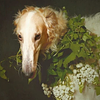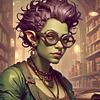Take a photo of a barcode or cover
The prose is good, and the symbolism thought-provoking, but I feel like I missed something-- or, rather, that it missed me.
This book definitely isn't for everyone, but I enjoyed it. It reads more like a loosely connected series of novellas, sort of like [b:The Years of Rice and Salt|2723|The Years of Rice and Salt|Kim Stanley Robinson|https://i.gr-assets.com/images/S/compressed.photo.goodreads.com/books/1419079388l/2723._SY75_.jpg|74882], and thus feels somewhat disjointed. I definitely think the novellas were of varying qualities- the first one is pretty good if very melancholy and the third is magnificent, but the second seems to have Martel engaging in a lot of pontificating and extended monologues that feel ham-handed and seem to tell the reader how to interpret the book rather than leave that up to them, unlike the one at the end of [b:Life of Pi|4214|Life of Pi|Yann Martel|https://i.gr-assets.com/images/S/compressed.photo.goodreads.com/books/1320562005l/4214._SY75_.jpg|1392700]. That being said, the second part seems to work better in retrospect, and I'm sure Martel had a reason for the long discourses. At a certain point I felt like this was going to be a retread of Life of Pi but with less left for the reader to figure out, and I was so glad when that was not the case. It uses similar tropes and ideas to that book but rearranges them in a unique and wonderful way to form a work that stands on its own in portraying peculiar intricacies of grief, home, and belief through symbols and motifs that are hinted at but never fully explained.
I definitely think that those who are saying this is more experimental than Life of Pi seem to be correct. It feels a bit more rough around the edges, but still was, in the end, a rewarding read for me at least.
I definitely think that those who are saying this is more experimental than Life of Pi seem to be correct. It feels a bit more rough around the edges, but still was, in the end, a rewarding read for me at least.
I found it to be very strange, but lovely and interesting.
Cerita yg sulit. Sulit dicerna, sulit dinikmati, sulit dimengerti. Tapi akhirnya, lega sudah membacanya.
Novel ini adalah tragedi 3 babak. Ketiganya menceritakan kesedihan seorang laki2 yg kehilangan istri. Dan meski terpaut puluhan tahun ketiganya 'terpanggil' untuk mendatangi Pegunungan Tinggi Portugal (ini nama wilayah, masih banyak sabana dan terpencil, di sekitar perbatasan negara Portugal dan Spanyol, cmiiw). Di sebuah desa di wilayah ini, benang takdir merajut jalinan cerita aneh, terentang puluhan tahun bercampur legenda dan mitos, penuh kesedihan, namun juga memberikan kelegaan.
Yann Martel memang bisa dikatakan menyukai gaya bercerita penuh metafora binatang. Dalam masterpiece-nya [b:Life of Pi|4214|Life of Pi|Yann Martel|https://images.gr-assets.com/books/1320562005s/4214.jpg|1392700] ada Harimau Benggala, sedangkan [b:Beatrice and Virgil|7176578|Beatrice and Virgil|Yann Martel|https://images.gr-assets.com/books/1442463960s/7176578.jpg|7627945] mengisahkan tentang keledai dan monyet. Pegunungan Tinggi Portugal ini punya bintang 2 binatang, Badak Iberia dan Simpanse. Hanya saja, sampai selesai membaca, aku masih kurang yakin pada kesimpulanku menafsirkan metafora-metafora ini.
Nb, saat baca bagian 2, ttg ahli patologis penggemar AC, jd kepikiran, novel AC mana ya yg ada tokoh anak2. Br inget 2, Crooked House dan salah satu cerpennya yg di Christmas Pudding. Ada lg g ya? ;)
#Scoop
Novel ini adalah tragedi 3 babak. Ketiganya menceritakan kesedihan seorang laki2 yg kehilangan istri. Dan meski terpaut puluhan tahun ketiganya 'terpanggil' untuk mendatangi Pegunungan Tinggi Portugal (ini nama wilayah, masih banyak sabana dan terpencil, di sekitar perbatasan negara Portugal dan Spanyol, cmiiw). Di sebuah desa di wilayah ini, benang takdir merajut jalinan cerita aneh, terentang puluhan tahun bercampur legenda dan mitos, penuh kesedihan, namun juga memberikan kelegaan.
Yann Martel memang bisa dikatakan menyukai gaya bercerita penuh metafora binatang. Dalam masterpiece-nya [b:Life of Pi|4214|Life of Pi|Yann Martel|https://images.gr-assets.com/books/1320562005s/4214.jpg|1392700] ada Harimau Benggala, sedangkan [b:Beatrice and Virgil|7176578|Beatrice and Virgil|Yann Martel|https://images.gr-assets.com/books/1442463960s/7176578.jpg|7627945] mengisahkan tentang keledai dan monyet. Pegunungan Tinggi Portugal ini punya bintang 2 binatang, Badak Iberia dan Simpanse. Hanya saja, sampai selesai membaca, aku masih kurang yakin pada kesimpulanku menafsirkan metafora-metafora ini.
Nb, saat baca bagian 2, ttg ahli patologis penggemar AC, jd kepikiran, novel AC mana ya yg ada tokoh anak2. Br inget 2, Crooked House dan salah satu cerpennya yg di Christmas Pudding. Ada lg g ya? ;)
#Scoop
After having much success reading David Copperfield in Thanet, and The Go-Between in Norfolk, I decided to read The High Mountains of Portugal in, well, Portugal. (We weren't in the high mountains, which would be in the north, were they not fictional, but we were on a mountain, so I called that close enough.) Reading the blurb, I kind of got the idea that this would be one continuous story, when it's actually closer to being three separate tales, none of which were particularly satisfactory.
At first, The High Mountains of Portugal reminded me more of London than of Fóia. The opening pages are all about Tomas, who walks backwards. There's a man I often see from the bus walking backwards through Tufnell Park and Kentish Town, so naturally I got sidetracked wondering why he does it, since he doesn't have the excuse of being a literary character. Even putting that aside, the Portugal I was reading about and the Portugal I was seeing in front of me seemed to have little in common — so much so that I was genuinely excited to find a description of cork trees, which I recognised.
Of the three stories, my favourite was the third, about Peter, a widow who adopts a chimpanzee and takes it to Portugal to live with him. Yann Martel did, finally, tie the three stories somewhat together. I particularly liked that people in the village Peter moves to have taken to walking backwards at funerals as an expression of grief. The ending of the story, which I won't spoil, was something of a downer — though not as much so as the ending of Island. The second section, billed as a 'murder mystery' on the cover, wasn't, but did have quite an interesting digression about the similarities between Jesus Christ and Hercule Poirot.
On the whole, I'd say The High Mountains of Portugal was something of a let down, but that won't stop me reading Waverley before my trip to Selkirk!
At first, The High Mountains of Portugal reminded me more of London than of Fóia. The opening pages are all about Tomas, who walks backwards. There's a man I often see from the bus walking backwards through Tufnell Park and Kentish Town, so naturally I got sidetracked wondering why he does it, since he doesn't have the excuse of being a literary character. Even putting that aside, the Portugal I was reading about and the Portugal I was seeing in front of me seemed to have little in common — so much so that I was genuinely excited to find a description of cork trees, which I recognised.
Of the three stories, my favourite was the third, about Peter, a widow who adopts a chimpanzee and takes it to Portugal to live with him. Yann Martel did, finally, tie the three stories somewhat together. I particularly liked that people in the village Peter moves to have taken to walking backwards at funerals as an expression of grief. The ending of the story, which I won't spoil, was something of a downer — though not as much so as the ending of Island. The second section, billed as a 'murder mystery' on the cover, wasn't, but did have quite an interesting digression about the similarities between Jesus Christ and Hercule Poirot.
On the whole, I'd say The High Mountains of Portugal was something of a let down, but that won't stop me reading Waverley before my trip to Selkirk!
adventurous
inspiring
mysterious
reflective
sad
medium-paced
Strong character development:
Complicated
Loveable characters:
Yes
Diverse cast of characters:
Complicated
Flaws of characters a main focus:
No
This book is similar to one of the author's previous books, Life of Pi. The story is similar in that you are not sure what is real and what is not. And an animal is also involved. In this story he intertwines different stories that have a single thread to tie them together. He even has bible study in the midst of the book. One of the characters going on a diatribe about Jesus being a story teller not a history maker.
This book confounded me. I am a huge fan of Life of Pi, so I picked this one up, and was mildly enjoying the tale of a man who has lost his wife, son and father trying to deal with his grief. He drives to the high mountains of Portugal, inspired by the diary of a priest. Shortly after his arrival, we start a new story, set decades later, about a coroner working in the same area who is visited by his wife. She spends pages describing how the novels of Agatha Christie are related to the murder of Jesus Christ. Then he's visited by a woman who has conveniently brought the the body of her dead husband to his office in a suitcase to be examined. Then things get really weird. I was trudging through this part and really wanted to give up, but then the third story started. It is the story of a man who has also lost his wife and visits a chimp sanctuary on a business trip and leaves having adopted one of the animals. He then moves to the high mountains of Portugal. I don't know what it was, but I loved this story. Thus, hard to say if I recommend it or not. I think it is supposed to be a meditation on grief, but perhaps some of it went over my head.
Read my full review: http://theadvocate.com/entertainment/books/15201950-123/high-mountains-waits-until-last-of-3-stories-to-hit-high-point
Read my full review: http://theadvocate.com/entertainment/books/15201950-123/high-mountains-waits-until-last-of-3-stories-to-hit-high-point
This book tried way too hard to be profound and fell flat from the effort. The writing is decent enough for two stars, but I found myself wishing the book was over from the very beginning.
Full review is on my blog: http://the-bookish-life.com/review-high-mountains-of-portugal-yann-martel/









